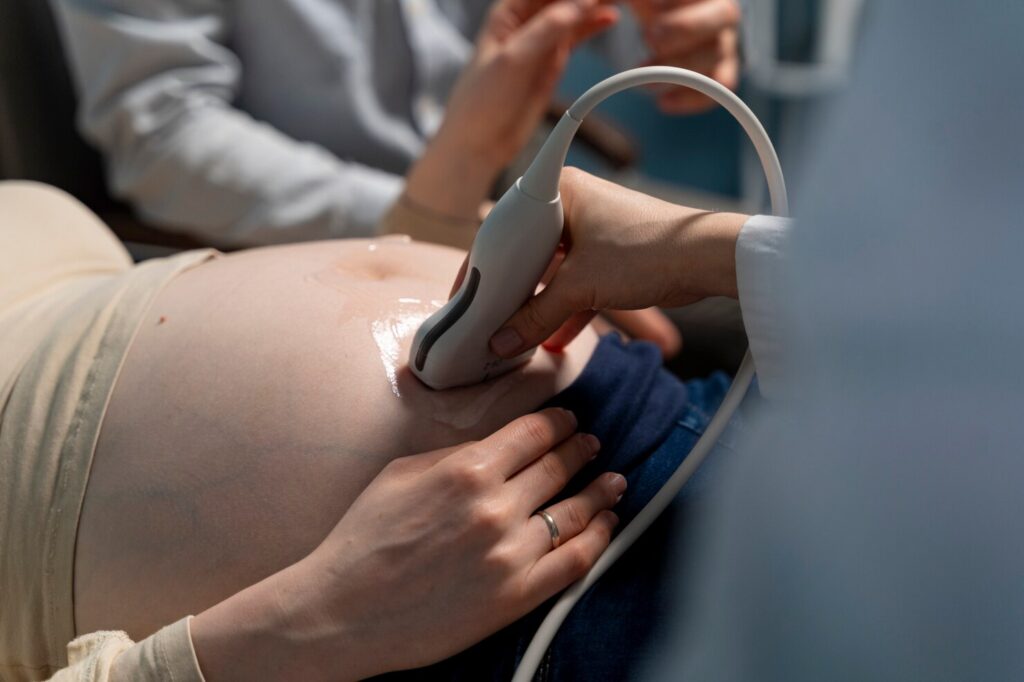- How to Determine the Approach of Labor
- How to know when labor has started
- Signs
- Lowering of the Belly
- Weight loss
- Digestive Disorder
- Braxton Hicks Contractions
- Passing of the Mucus Plug
- Amniotic Fluid Leakage
- Contractions
- Other Signs
- Is it possible to miss the signs of impending labor and the labor itself
- Signs during the first and second pregnancy
- What to do if labor starts
Labor! A thrilling, long-awaited, and indeed responsible moment. Expectant parents wait for this moment for 9 months, and some wait for this day for years. It is no surprise that in such a mode of anticipation, especially in the last two weeks before the due date, every baby’s movement seems like the moment “X.” But how to determine whether labor has truly begun, and what to do when the baby is ready to be born.

How to Determine the Approach of Labor
Often, the body signals the approach of labor long before it starts. Each day, the body prepares more to ensure the arrival of the baby is as comfortable as possible. However, the question of how to understand that labor has started worries every expectant mother.
Of course, the best way to determine the approach of labor is with the help of your gynecologist and ultrasound specialist. Tests will help set an expected due date. It’s useful to rely on this when preparing. However, it is undoubtedly important to listen to your body as well. Among the most common early signs preceding labor, one can note:
- Dropping of the abdomen.
- Weight loss.
- Digestive disorders.
- Practice contractions.
- Approaching the set date.
These are the first “swallows” that precede labor. It’s worth paying attention to them and informing your supervising specialist. They will conduct an examination and determine whether the expectant mother needs constant medical supervision, or if waiting for labor at home is possible. By the way, by this time, it’s better to have prepared all the necessary items for the maternity hospital.
How to know when labor has started
In fact, the feeling of labor starting is hard to confuse with anything else. However, it’s important to pay attention to the primary signs that will allow timely contact with specialists and reduce risks during the labor process.
The clearest signs that you will meet your baby in the next 24 to 48 hours are:
- Passing of the mucus plug.
- Breaking of the amniotic fluid.
- Contractions with equal intervals that increase over time. At the onset of contractions, it is advisable to note them down on paper. This will help doctors determine the interval and also let you understand if their frequency is increasing. For practice contractions, the frequency does not increase, and after 3-7 times, the contractions may stop altogether.
Additionally, it’s important to pay attention to accompanying factors. Among them are pulling pains in the lower abdomen, a feeling of pelvic bone separation, and others. We will discuss each sign in more detail and how to understand that labor has started further on.

Signs
It is necessary to monitor your health throughout the pregnancy. However, a couple of weeks before labor, you need to be on alert and note any changes. We will cover the main signs of labor starting, from the very first to the key ones that signal labor is about to begin.
Lowering of the Belly
One of the first signs of impending childbirth is the lowering of the belly. This occurs approximately 2-3 weeks before labor, depending on individual characteristics. At this point, the baby takes a favorable position for the upcoming birth.
Physiologically, this is related to the baby pressing its head (if the baby’s position is correct) against the lower part of the uterus, causing it to move into the pelvic area.
Besides the fact that you will literally see your belly drop, you will feel easier to breathe. The baby will no longer press on your ribs and support your lungs. However, walking and sitting will become more difficult. And you will have to go to the bathroom more often now.
Weight loss
At the same time, you may lose a few kilograms. The hormone progesterone begins to be produced in significantly smaller amounts, which leads to the removal of excess fluids from the body. The good news is that swelling will go away or significantly decrease. As you can see, the first signs can be quite pleasant.
Normally, you may lose up to 2 kilograms. If weight loss occurs rapidly and in large volumes, you should consult a specialist. Exhaustion is the last thing you need before giving birth.
Digestive Disorder
The aforementioned changes also affect the digestive system. It’s important to closely monitor the associated symptoms of intestinal disorders. If you do not experience unusual nausea, vomiting, or a significant increase in temperature, the disorder is likely caused by the natural hormonal changes occurring before childbirth. If additional warning signs accompany the bowel disorder, it’s advisable to consult a doctor and check for the presence of E.coli.

Braxton Hicks Contractions
Another “exciting” sign of impending childbirth is Braxton Hicks contractions. The body prepares itself for childbirth two to three weeks in advance. In this way, the uterus is ‘training’ itself. These are characterized by painless sensations of involuntary contractions and hardening of the uterine muscles for a few seconds. Braxton Hicks contractions can occur in chains several times in a row.
It is worth noting that in some cases, the initial signs in the form of Braxton Hicks contractions do not occur, or are so subtle that the woman does not feel any changes in her body’s behavior. However, some women experience Braxton Hicks contractions quite acutely. If they do not last long, there is no reason for concern, but if their frequency increases and they last longer than usual, it’s advisable to call an ambulance, as the hour ‘X’ may have arrived.
Passing of the Mucus Plug
Now we move on to more significant signs of approaching labor. Passing of the mucus plug is one of the clearest indicators that it’s time to head to the hospital, or at least consult with your gynecologist.
The mucus plug is a protective barrier created by the body. It prevents microbes and infections from entering the uterine cavity, thus protecting both the mother and the baby. Before labor, the cervix softens and can no longer ‘hold’ the plug.
Externally, the discharge has a thick, jelly-like texture. It can be completely transparent or have a coloration ranging up to pink and red colors. The discharge has a distinctive appearance, and you definitely won’t confuse it with regular discharges.
Amniotic Fluid Leakage
Another clear sign is the leakage of fluids. You’ve surely seen this in every movie with a childbirth scene, and the main character’s cry “my water broke” is likely ingrained in your memory.
While the baby develops, it is protected by the amniotic fluid. When the baby is ready to be born, the sac ruptures, and the fluid naturally flows out. In such a case, it is essential to urgently go to the hospital, as the baby could be born in the coming hours.
Important! After your water breaks, do not get behind the wheel under any circumstances. The timing of labor is highly individual, and even you cannot predict how your body will react.

Contractions
Now about the most important first sign of impending labor — contractions. Why the most important? Sometimes the water breaking and the mucus plug passing never happen, but contractions always come!
Regular contractions, which bring news to the future mom, have one characteristic — they become more and more intense, and the interval between them shortens.
At this time, the cervix dilates, and the baby begins its slow movement “to freedom.” It is crucial to head to the hospital and be under the supervision of specialists.
In rare cases, a woman feels contractions quite weakly. Then it is important to pay attention to the due date and the regularity of the contractions.
Other Signs
Among additional signs of impending labor, it is worth noting a change in mood, taste preferences, you may start to feel more tired and sleep longer, or conversely, have restless sleep. What should you do about this? First of all, don’t worry. If the symptoms cause you significant discomfort (for example, you can’t control your anger and tears, or you’re overcome with insomnia making it impossible to get a good night’s sleep), you should consult your attending specialist. They will prescribe safe sedatives. Believe me, you’ll need your strength, so do everything you can to get plenty of rest a couple of weeks before giving birth.
Is it possible to miss the signs of impending labor and the labor itself
As practice shows, this question very often arises during a gynecologist visit. If a woman is giving birth for the first time, hundreds of questions arise in her mind that simply need answers. And, no matter how absurd the question may seem to specialists or experienced mothers, it is worth addressing it as well.
- So, is it possible to miss the first signs of labor beginning? Some signs, yes! But not all. For example, a future mom might not notice the belly dropping, especially if it was small. You might miss the moment of Braxton Hicks contractions, changes in diet or mood may not occur. You might not be experiencing problems with swelling, so you won’t notice when it stops. However, it is impossible to miss the contractions, the discharge of the mucus plug, or waters breaking (if it happens). Believe us, one of the signs that you will soon head to the hospital you will surely notice. We are not even talking about maternal intuition and the overall perception of your own body.
- Can you skip the childbirth process? — Absolutely not! No matter how much you fear it (or dream of it), no woman has ever skipped the birth of her child.
We want to emphasize that you should not be shy about asking questions to your doctor or in a chat in a medical app. If you keep these questions to yourself, the only thing you’ll gain is insomnia.

Signs during the first and second pregnancy
The signs of labor can vary depending on whether it is your first or subsequent pregnancy. Generally, the signs of labor during the second pregnancy are similar to those of the first, but there are a few differences:
- The belly may drop just a few days before labor.
- The waters may break much earlier than contractions start.
- Practice contractions may be less noticeable or absent altogether.
The difference can be either insignificant or striking. This largely depends on the time interval between births.
It’s important to remember that every birth is individual. If the first birth was difficult but natural, it doesn’t necessarily mean the second will have the same complications. Always keep a positive mindset and listen to your doctor.
What to do if labor starts
If you notice signs that labor is starting (or you think it might be), you need to do two things — stay calm and go to the maternity hospital. In some cases, you may afford some delay, in others, you need to act more swiftly. For example:
- If you notice that the mucus plug has come out, you should contact your gynecologist. You may be invited for an additional examination or sent to the maternity hospital.
- If your waters have already broken, it’s time to gather your things and get to the maternity hospital. From this moment on, you need constant supervision. However, remember the rule not to drive.
- If you have started contractions that are becoming more frequent (regardless of whether the waters have broken or not), you should call an ambulance or urgently go to the maternity hospital.
To ensure the process is as safe and comfortable as possible, it’s worth following a few rules even before the first signs of labor appear:
- Avoid long trips a couple of weeks before the expected due date.
- Gather all necessary items for childbirth and place them near the exit.
- Decide in advance on the maternity hospital where you will give birth.
- Write down the phone numbers of the hospital, doctor, and gynecologist on paper, and put it in a visible place in the apartment so that in case of necessity, your relatives have access to the numbers.
- Always carry your documents with you (including the expectant mother’s card) in the last couple of weeks before childbirth. In case of an emergency trip to the hospital from outside the home, the attending doctor will be able to immediately access the initial data that will help with the delivery.
If everything is planned correctly, the first signs and moment of labor will go as smoothly as possible, allowing you to focus on the main thing — the birth of your child. The momslab.app application will help you prepare for childbirth 100%.


Download the app and get 7 days free use
 eng
eng rus
rus deu
deu spa
spa fra
fra ita
ita por
por srp
srp tur
tur ukr
ukr por
por bos
bos



